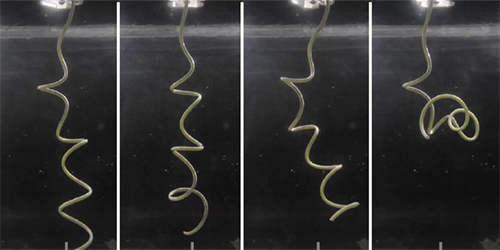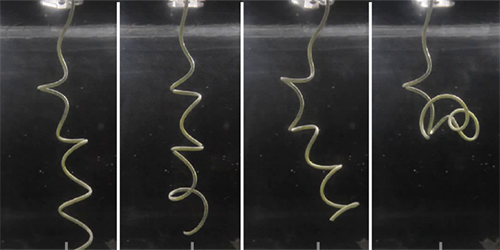Buckling in Bacteria Tails
Many bacteria swim by rotating a helical-shaped tail, called a flagellum. The complex mechanical interaction between this coil and the fluid is not completely understood, but new experiments with a “flagellum simulator” characterize an important limit to this motion: when the coil turns too fast, it buckles like a spring that’s overstretched. Using a theoretical model, the researchers estimate the buckling threshold for real bacteria and find that all of these organisms rotate their flagella just below this limit.
Bacteria propulsion can be understood as the interplay of elastic forces in the flagellum and viscous resistance from the fluid. Studies of bacteria motion have often assumed a simplified model in which only short-range viscous forces are included. However, recent experiments have shown that long-range hydrodynamic interactions occur between flows produced by different parts of a flagellum.
To develop a more accurate model, Khalid Jawed from the Massachusetts Institute of Technology, Cambridge, and his colleagues performed experiments on 20-centimeter-long rods molded out of rubber into different helical shapes to mimic flagella. They then rotated the rods in a viscous fluid (glycerin) at various speeds. A video camera captured the change in the helical shape and eventual buckling as the rotation rate was increased. The researchers’ model—which accounted for long-range hydrodynamics—showed that the propulsive force increases with rotation speed but drops off suddenly once buckling occurs. Using bacteria data from the literature, the team estimated the flagellum rotation rates to be near the buckling threshold, suggesting that the organisms maximize their propulsion within the buckling limit. The authors speculate that these microbes may also sometimes intentionally buckle their tails to turn direction.
This research is published in Physical Review Letters.
–Michael Schirber





